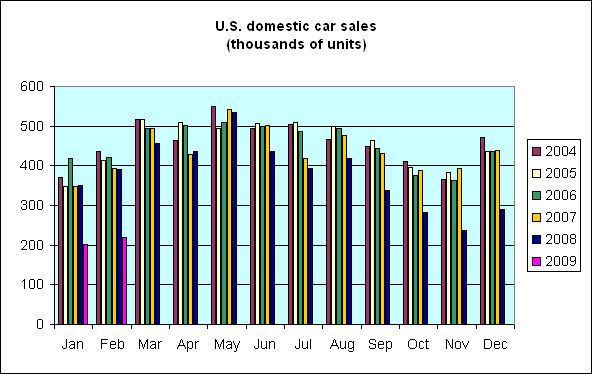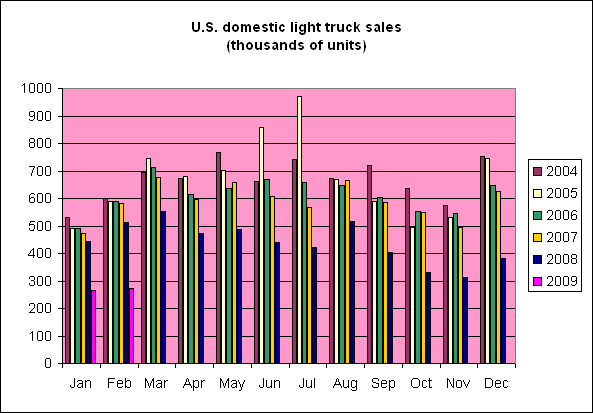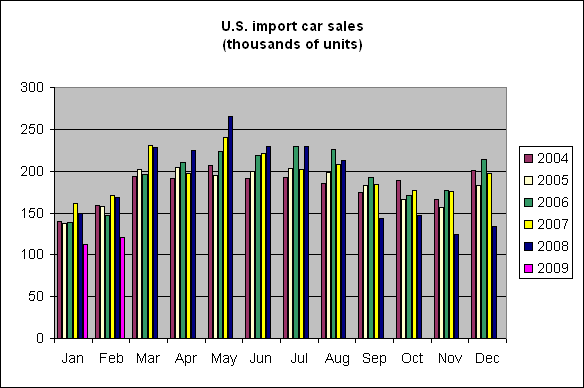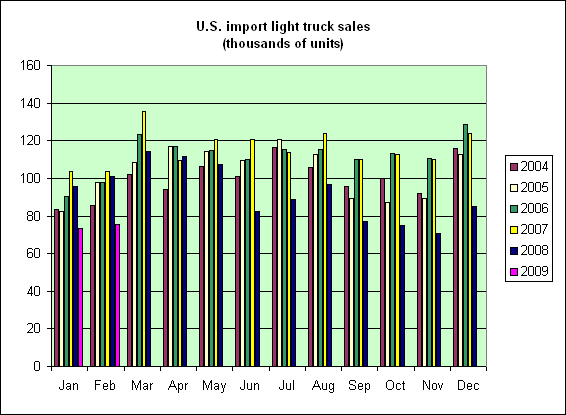Detroit is still down, and the count begins on whether that means out.
Americans bought slightly more cars manufactured in North America in February than they did in January, though in a usual year we’d expect a bigger January-to-February increase. In terms of year-over-year comparisons, January car sales were down 42% from January 2008, while February was down 44% from ’08:
 |
Same story with the separate category of light trucks, which includes the once-popular SUVs. Year-over-year sales of domestically manufactured light trucks were down 40% for January and 47% for February.
 |
And it’s not just the U.S. automakers. Though not hit quite as hard as the domestics, imports are also down significantly, with sales of imported cars down 28% from February ’08 and imported light trucks down 26%. Honda, Toyota, Nissan, Mazda, and Mitsubishi have all been reported to be inquiring into assistance from the Japanese government.
 |
 |
These low levels of sales are unsustainable in terms of fundamental dynamics on both the demand and supply side. On the buyers’ side, Calculated Risk noted that current sales levels would be consistent with a constant stock of vehicles only if Americans plan to hold onto their cars for a quarter century. Even if Americans don’t want more cars– and eventually we will– there is clear potential for a very significant rebound on the demand side. It’s just a matter of when.
And on the supply side, with the auto industry’s huge fixed costs, sales at these levels imply horrific cash outflows which the U.S. automakers simply have no means on their own to ride through. The U.S. Treasury may dole out emergency funds on a month-to-month basis, but eventually that game is going to be up. That seems just a matter of when, too.
So the question is, which when is going to come first?
Technorati Tags: macroeconomics,
autos,
auto sales,
economics,
recession
I would love a new car, but ended up paying out of state tuition for number one son and perhaps for number two son since Arnie so wisely cut our UC and state school budgets in California. So, at least we are improving Arizona’s economy.
Hey Arnie, the kids have no jobs and can’t get into the schools. Have you noticed?
“…which when is going to come first?”
Funny how economic questions about aggregates are ultimately almost never about levels but about time.
Mexican Standoff anyone?
I get Jim on the light truck, ultimately these never go away and their is little to substitute for them with respect to its business function.
If you look at GM’s most recent sales reports, their units in January and February were down just over 50% (yr-yr).
Given the high fixed costs of the business, worsening economy and inflexibility of bondholders and other stakeholders to cooperate, GM and C are going into Chapter 11 sometime in the next month or two.
My question is, what happens to monthly sales when/if GM and C go Chapter 11. On the optimistic side, the -50% collapse in monthly sales may reflect anticipation of the bankruptcy; on the pessimistic side, a bankruptcy filing could at least temporarily push sales down into the -75% monthly range. It seems to me that’s the main issue for GM and C as ongoing businesses.
If they declare bankruptcy and sales stabilize around -50% or even improve, then Chapter 11 may be a workable solution to their troubles. But if sales under bankruptcy collapse from -50% to -75%, it may be doubtful or impossible for the companies to avoid a liquidation bankruptcy outcome.
Cars manufactured in North America is a much broader category than GM Crysler and Ford.
What is the definition of “domestic cars”?
If we want to talk specifically about GM, much has been written about the mistakes made by GM management and the UAW. A summary would not do the subject justice. A recent good discussion is available in the February issue of Imprimis, a publicatiojn of Hillsdale College. This is a suprising source for a detailed discussion of an automobile manufacturing company but the author is Joseph B. White who covered the automobile industry for the Wall Street journal from 1998 to 2007. White remains a resident of Detroit.
The main point is that the people who made the decisions at GM were not up to the challenge provided by the Japanese. Their efforts were timid and misdirected. One quote from the White article – “Another person who warned GM about the nature of the Japanese challenge was Jim Harbour. In the early 1980’s, he took it into his head to try to tell GM’s executives just how much more efficient Japanese factories really were, measured by hours of labor per car produced. The productivity gap was statling – the Japanese plants were about twice as efficient. GM’s president at the time responded by barring Jim Harbour from company property”.
After the American auto market returns the Big 3 will still have significant trouble. They built their business over the last two decades around passenger trucks. They provided a larger profit margin due to a loophole in the emissions legislation designed for farm equipment. The extra profit garnered from these vehicles kept them afloat. Once that market collapsed during the oil speculation bubble of last summer, they were in trouble. Designing newcars and retooling a factory takes years. The American auto market is experiencing a fundamental shift as consumers seek out low-cost no-frills cars. Even when the annual national sales rate reruns to the 14M range, the big 3 will not be in the position to take advantage of it.
or perhaps families will decide that second or even third car is unnecessary….
The argument that CR makes assumes that the number of cars on the road stays constant or grows. That might not be the case if families are downsizing to one car from two or two cars from three.
JDH et al,
Apropos of “things are tough all over,” I ran across this slideshow about a week ago:
http://www.guardian.co.uk/business/gallery/2009/jan/16/unsold-cars?picture=341883529.
Scary stuff.
The sooner GM goes bankrupt, the better. It is such a burden to the US economy, and they should not be subsidized to produce cars that people don’t want.
Auto workers in unions make $150K a year, to produce cars that are poor quality. The whole thing must implode in on itself for a rebirth to begin.
Note that ‘units’, as shown in these charts, is only a partial picture.
A major dimension of the correction involved people who previously would have bought a $40,000 car now buying a $30,000 car, and the former $30,000 car customer now buying a $17,000 car. As this is an easier adjustment to make, I would expect this to happen even before units fell outright.
What would be really useful would be to see a chart of the average age of cars in operation, extending from 1970 to today.
This will tell us more about Calculated Risk’s point about whether a demand snapback is imminent. If the average car is over 8 years old, eventually new ones have to be purchased.
Technology is a disruptive factor here, however. Hondas and Toyotas, especially in California where there is no snow, are known to easily last 15 years. This is postponing the purchase of new cars.
At the same time, as newer model cars are getting more technological features, affluent customers are ‘upgrading’ their cars long before mechanical failure. Their 2001 BMW 7-series does not have all the gizmos that the 2010 model has, and so that customer upgrades, even though the 2001 car is running just fine.
Electronics are now 20% of a car’s price. Since electronics depreciate 20-35% a year, that is significant.
There are many positive indirect effects.
Fewer cars sold means :
1) More teenages prevented from driving = fewer accidents, as drivers between the ages of 16-19 cause a disproportionate number of accidents. In addition to the loss of life, a major car crash costs about $2 Million in ambulance, police, hospital, and court costs. Not to mention that the highway is backed up for an hour = thousands of hours of productivity lost.
2) Fewer cars sold = less gasoline consumed = less oil imported – lower trade deficit
3) Fewer cars sold = less traffic and easier to find parking.
there was a bloomberg article last week that said there are a lot of people that will buy cars but it won’t translate into triple a paper. the car loan companies are hoping that lower but still decent credit score loans wil allow them access to some aid. apparently bloomberg article scrolled off.
bronte capital blog had an interesting point on used car resale prices being the determining factor in loan loss recovery.
http://brontecapital.blogspot.com/
1. It is patently unfair to Ford, Honda, Toyota, & any other US auto manufacturers having their taxes going to subsidize their competitors GM & Chrysler.
2. When interest rates eventually express the interplay of actual savings vs. the demand for loans–to wit, the market prevails over central bank manipulation–interest rates will be considerably higher than they are currently. This will depress demand for autos in a non-cyclical manner.
“These low levels of sales are unsustainable in terms of fundamental dynamics on both the demand and supply side. On the buyers’ side”
The demand side is giving economist and their models more evidence that their models are worthless and need considerable repair. No science what so ever to suggest such silly notion that Americans must,need,can’t live without a new car every X years. If this period of demand destruction has taught the economic profession anything its that they are clueless.
GK:
“Auto workers in unions make $150K a year”
Please note the new hire rate.
The Associated Press reported that, for example, the average United Auto Workers member makes $29.78 per hour at GM, while Toyota pays its workers (most of whom are non-union) about $30 per hour. However, when total benefits (including pensions and health care for workers, retirees and their spouses) is factored in, GM’s total hourly labor costs is about $69, while Toyota’s is about $48.
The Japanese automaker has fewer retirees in the U.S., and its health care benefits and pensions are less generous than those negotiated between Detroit and the UAW. Another key point is that health costs and pensions for auto workers in Japan – worth billions – are subsidized by the Japanese government. Not so in the U.S.
UAW representatives were wary of renegotiating its contracts again, after having already settled for lower wages in its contract talks with GM earlier this year. [New hires at GM are paid $14-$16 an hour; Ford and Chrysler also pay new hires less; this has stirred the companies to offer buyout packages to their older workers.]
http://www.cbsnews.com/stories/2008/12/19/business/main4677571.shtml
CR’s sorta hopeful remark assumes that cars won’t last 25yrs like those ’56 chevies in Cuba, so this dive can’t last forever. But I wonder if it resettles to another level…(like the computer industry too), maybe not Cuba’s but possibly Europe’s…you pick the country –Poland?
Broadly, the car is an icon that is going to be downsized in the American psyche…for good. In all senses wouldn’t you say? I mean, reconsider: We drive a 2 ton vehicle to get our lard asses to anything further away than a couple of blocks.
More broadly, those “American interests” in the Middle East (a secure supply of gasoline) coerce us into bankrolling an out-sized military to carry on with our lard assing.
So, I’m hopin for that lower auto level…a more communal transport would be good, yes?
There is a great elasticity in the average age of a nations car fleet. In Germany analysts were expecting car sales to pick up since 2005 because average age was about 8 years. Now it runs up to 9 years and sales wouldn’t have picked up were it not for the new subsidy the government provided recently. So although CR makes a very rational point it is very hard to tell if that will have an impact in the near future when it is most needed
Another key point is that health costs and pensions for auto workers in Japan – worth billions – are subsidized by the Japanese government. Not so in the U.S.
There’s no free lunch. Health care subsidized “by the government” will still come out of the bottom line of businesses.
You can respond by saying that our health care system is about 60% more expensive than other countries, and you would be absolutely right on that.
Saying that demand for cars in the US must necessarily increase to keep the size of the car fleet constant is a bit similar to saying that India will have 500 million cars on the road by mid-century because of its population size.
Demand depends on the ability of people to afford what they want. And it depends on them continuing to want the same things they wanted in the past.
I am very happy with my 1999 and 2002 GM products. The SUV and car were built to last and I intend to drive them until I can replace them with electric vehicles, that is 2010 or 2011. The question is not when but what kind of car. There has been a sea change in the consumer, we do not want to feed the OPEC nations anymore as this has caused tyrants to gain great power. Iran and Venezuela, to name a couple. Take away their oil dollars and create an American industry that runs on renewable resources, clean coal and nuclear. GM leads the world in electrical car technology, their business plan missed by two years. Were done with oil and Obama needs to understand how deep the desire is to get rid of the OIL ECONOMY. It has reached Middle America, keep gas prices high and push for a new economic model based on home grown power. Then American can export the technologies to the world along with product. The entrepreneurs are ready, we the captains of industry and the banks, to smell the coffee, ie. profits and take some risk, risk, risk.
I bought a high performance electric motorcycle, manufactured in the US, instead of a new truck or full size SUV from the big US automakers. I got tired of waiting for the big US automakers to start producing the electric vehicles that they should have started churning out in 1973.
Echoing Thomas:
1. It’s the credit crunch.
2. It’s the economy, with employees (consumers) being hammered.
2. Consumers are waiting for automakers to produce what the consumers actually want, efficient, functional vehicles.
US gasoline consumption is up year over year.
US cars sales have been roughly flat for at least 17 years (before this crash), with an annual growth rate of 1.25% from 1990 to 2007. New car sales prices increased by 25% in the three years to 2005, and decreased modestly thereafter until the recent crash, when they have cratered.
There was no visible bubble in US auto sales; therefore, we might expect a substantial recovery. I personally would not be surprized by a big step up (to a 12 m unit pace) within relatively short order.
Professor,
To put wages in perspective –
Avg. per Hour
GM $39.68
Ford $28.88
Chrysler $29.15
Toyota $24.00
Honda $24.00
US Natl. Avg. $19.12
Michigan $20.30
Ohio $18.38
Avg. per Hour with Benefits
GM $73.26
Ford $70.51
Chrysler $75.86
Toyota $48.00
Honda $48.00
US Natl. Avg. $27.31
http://www.nytimes.com/2009/02/22/business/worldbusiness/22japan.html?_r=2&ref=business
I got this from the naked capital blog, it’s
a New York Times article.
“Today, years after the recovery, even well-off Japanese households use old bath water to do laundry, a popular way to save on utility bills. Sales of whiskey, the favorite drink among moneyed Tokyoites in the booming 80s, have fallen to a fifth of their peak. And the nation is losing interest in cars; sales have fallen by half since 1990.”
I am of the opinion that either car sales will recover–or they won’t.
So Steve offers a counter factual to CR’s report that fewer miles were driven recently…that could be it “year after year” until 2008. And possibly counter factual to JDH’s view of that supply of gasoline continuing for very much longer in any case.
My impression is that the auto industry has been in deflation while the housing industry was inflating –providing the funding for these rust-bucket icons since 2005? …earlier. I think if you miss this impression, you are following, and possibly marketing, dated information/indoctrination. This is not the 90s and we are not chumps.
Professor, this is The Greater Depression, and demand for autos will not be returning anytime soon.
Per the article, below, current production is off 67% from peak, while the drop in The Lesser Depression was 75%.
Production of cars and trucks plunged in January tothe lowest (level) since the Federal Reserve began keeping records in 1967, and 67 percent below the January 2005 level U.S. motor vehicle output slumped 75 percent from 1929 to 1932, according to statistics in the book American Automobile Workers 1900-1933, by Joyce Shaw Peterson
http://www.bloomberg.com/apps/news?pid=20601109&sid=a1ItlrP4MeQQ&refer=home
jg,
Just as a frame of reference international reaction to Hawley-Smoot knocked auto exports in the teeth during the Great Depression. So when analyzing production levels you need to take that into account.
firecat writes, “I am of the opinion that either car sales will recover–or they won’t.”
Don’t go out on a limb. lol. I am of the opinion like pigeon, that there is elasticity in the fleet. Toyotas and Hondas last forever. Even the cars built by GM, Ford, and to some extent Chrysler last a lot longer than they used to. I just sold an 02 Chevy Avalanche to a guy that traded in a running 88 model Ford Taurus. The Avalance only had 70k miles and will easily last another 5-10 years depending on use and care. He financed it at his credit union on a five year note!
Short of the end of availability of gasoline and spares for my car, I would be happy to drive it for 25 years. It is a nice car. In 25 years I will be 98 and in need of many spare parts that are not going to be available. As our lord Keynes said: In the long run we are all dead.
PS
My Dodge Pickup is 19 this year and running strong.
the Cummins engine will last forever but the body and other fittings won’t.
The only reason to buy new is new technology or as above, you can’t find the gas or parts to keep it running.
dd
Firecat, two things are different about the Japanese relative to the U.S. — (1) their demographics are the most age challenged on earth: their labor force peaked in 1998 and absent immigration which is anathema in their xenophobic culture the labor force cannot grow for at least 18 years, and (2) it’s going to have to get a lot worse here before my neighbors start reusing their bathwater!
As for me, I’m officially in the depression camp these days – this decline is so synchronous and global, there’s not been anything like it since the 1930s.
http://www.guardian.co.uk/business/gallery/2009/jan/16/unsold-cars?picture=341883529
Thank you psummers. Those are dramatic slides. Scary stuff indeed.
What happened to just in time (JIT) inventory management practices?
GM’s president at the time responded by barring Jim Harbour from company property”.
Posted by: ReformerRay at March 8, 2009 09:38 AM
Wise move.
Domestic cars – it’s those with the Detroit-style design. These cars are made north of the Mason-Dixon if not just north of the Mexico-US border. They are designed by US designers for US audiences and are not confused with being golfcarts a la Toyota, Honda, Tata, or Hyundai.
Will do, thank you, Dick, for the reminder.
Kind of makes this fall off even more dramatic, eh? Huge drop off in production even before the inevitable protectionism that comes with a depression kicks in.
In fairness to the Japanese, it should be remembered that they wash before getting in their baths. I believe that they were using their bathwater for washing even during the bubble period!
putup for file
I think all of you have good points. However, here is reality.
I would love a new car. I am in the market for a new car because my car is worn out. However, when I go to the the bank to get a car loan they are not nearly as nice as they used to be. Instead of offering me 6% interest they offer 15% interest. My credit score is not that bad to justify 15% interest and in the end they didn’t give me the money saying I was too big of a risk.
I am a home owner that still has equity in their home I have stable job and I only have one credit card with a low balance. Still I cannot get the credit to buy the car. So autos will not turn around until banks start lending.
I will admit that I am trying to buy a small high gas milage car.
Let me know what you think.
How would leasing affect these numbers?
If they are already included, the fact that most companies are moving away would mean a drop since people are not going to trade in new cars every 2 to 3 years. Since the hassle of selling a used car is far more than just letting the lease expire.
Ford already dropped it on new trucks large and small.
So just with losing out on leasing it would seem like the average First car owner would go from 2-3 years to about 4-5 years. Im sure that you may have a formula for it for a more accurate estimate.
And there are people that have made $150k in the factories, but they are usually people that have been working there for many years so they have higher per hour, and they are pulling in a huge amount of over time working sometimes over 80 hour work weeks.
So to toss those numbers out like it is a bad thing, is sad. You have people that work extremely hard and long making a great living for their education level and you want to look it like it is someone working regular hours days after being hired. Even to talk like it is the norm is ignorant.
We need to get better educated as a nation, but by losing all the jobs that pay well to the hard working class is not the way to do it.
I too would love to get a new car, preferably a hybrid, even though gas costs are for now significantly lower than last year. I also agree that there should not be cars being manufactured, wasting our time, energy, fuel, and other resorces, when there is no demand for them. My city has been very focused on public transportation this past year, putting in a new tracks system for the first time, and lowering the number of cars on the road. However, since there is no way to get from one station to the other still, in some cases, it is still necessary to own a vehicle, you just don’t have to put so many miles on it. I’d like to see more money put into public transportation, like an underground or other train system, and less into personal autos that no one seems to be able to afford right now anyways.